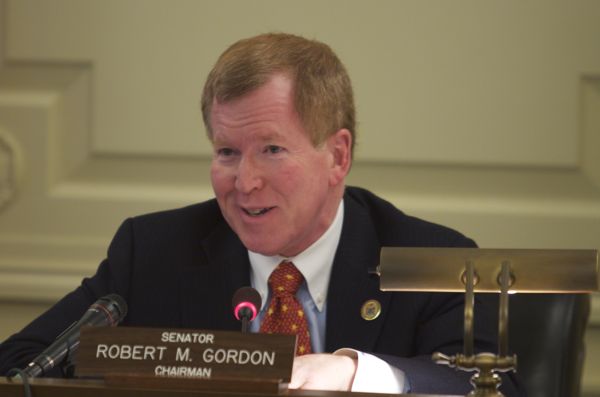Christie DEP Relaxes Toxic Vapor Intrusion Standards
Industry Consultants Rewrite Toxic Cleanup Standards
Stunning Hypocrisy In Light of Drinking Water Standards Debate
[VERY Important updates below – please read results of DEP meeting.]
In another illustration of the “regulatory relief” policy mandated by Gov. Christie’s Executive Order #2, after months of meetings with an industry work group, DEP quietly relaxed standards for “vapor intrusion” (VI) – just exactly as we repeatedly predicted, see this and this and this.
The VI standards rollback was announced in a January 17, 2013 DEP email to private Licensed Site Professionals and will be presented at 1 pm today at the DEP building.
The DEP’s new Vapor Intrusion Guidance (VI) document relaxes standards for several toxic chemicals found in groundwater, soil, and indoor air of buildings. Strict VI standards were set by DEP in 2007 (see the 2007 stricter standards).
[Update: DEP weakened (increased) VI standards for 103 screening values, some by thousands of times, but strengthened just 13 standards – that means 89% of changes made were to weaken protections. see below.]
As the Bergen Record reported back on May 31, 2011, the weaker standards to be announced today were developed by an industry work group (see Polluters rewriting rules for site cleanup:
Key committees writing rules for New Jersey’s new program to clean up contaminated sites are made up entirely of the polluting companies and their contractors.
The 16 committees, which have been putting together rule and guidance documents,include no one from environmental or resident advocacy groups, no health specialists, and no outside experts who aren’t affiliated with the cleanup industry. [….]
O’Brien & Gere also has a representative on a committee. The contractor was hired by DuPont to install vapor mitigation systems in homes in Pompton Lakes affected by a plume of contamination that spread from an old factory site. Environmental advocate Bill Wolfe, a former DEP official now with Public Employees for Environmental Responsibility, is concerned that contractors and polluters are writing the guidelines.
“It’s like a blank check to technical consultants to write their own requirements,” he wrote on his blog.
The weaker VI standards come at a time when, after 3 years, the Christie DEP has not strengthened any environmental standard and is supporting a chemical industry Legislative initiative to put industry representatives on the Drinking Water Quality Institute to write drinking water standards and undermine the science of risk assessment.
Ironically, the chemical industry DWQI kill bill is justified by false claims that the DWQI is not transparent and does not allow industry input.
But in stunning contrast with the DWQI, the VI standards development truly was non-transparent, completely dominated by industry, and are based on, at best, opaque science – yet all these real and serious flaws are ignored while sham industry claims are backed by DEP. Truly stunning.
Further politicizing DEP science and standards issues, DEP Commissioner Martin – who has no training in science – even went so far as to falsely claim that the nationally recognized DWQI science was “shoddy”. Here are direct quotes from Martin testimony to the Legislature, per Bergen Record):
Under questioning from state Senate Majority Leader Barbara Buono during budget hearings on Tuesday, Martin said he originally intended to sign the proposed rule until he realized “our science was shoddy and I refuse to sign anything that doesn’t have adequate science to back it up.”
He said of the DEP researchers: “The data they provided was poor, not organized, anecdotal at best.” Martin also said nobody was able to document the public health risk of the chemical to his satisfaction.
Yet the the DWQI meets openly, allows all parties to provide input, conducts nationally recognized risk assessment, and provides a robust scientific justification of their recommendations for drinking water standards.
See for yourself – here is an example of that work – note how the DWQI Report clearly states which specific chemical standards they recommend, explains the the scientific basis for those recommendations, and identifies whether recommendations would increase or decrease any existing standard so the public can see exactly what is going on and why.
Now compare that DWQI work to the DEP justification for relaxing the 2007 Vapor Intrusion standards.
1. Note how it is impossible to determine the scientific justification of the VI changes, which are not transparent because they are hidden in various models – and seemingly cherry picked apples and oranges from various EPA regions.
2. Note especially how DEP fails to specify which chemical standards are increased (weakened) and which are lowered (strengthened). This makes it very difficult for the public to be made aware of the implications of the changes.
3. Note that, contrary to the DWQI independent science, that the DEP VI standards are developed by an industry dominated work group that was established by invitation only – the participants were hand picked by DEP managers, and some have alleged that “pay to play” was involved.
The linkage between political “pay-to-play” donations and access to DEP prompted a scathing Star Ledger editorial about how one engineering firm dominated the process:
Langan Engineering & Environmental gave $25,000. It received $2 million from state agencies last year, and a senior associate of the firm sits on the state’s Site Remediation Professional Licensing Board, which oversees cleanups of contaminated sites.
None of this is criminal. To qualify as a bribe, evidence would have to show that these payments were explicitly linked to winning government favors. No one has alleged that here.
But Christie himself, when he was a federal prosecutor, favored the ban on big donations from firms doing business with the government.
He understood that it’s a sleazy practice that puts both parties within winking distance of a bribe, and that it engenders widespread mistrust.
( Langan Engineering had 9 staff involved in writing the DEP cleanup requirements, by far more than any other consulting firm, providing not only access but obvious insider knowledge, a distinct competitive advantage in the consultant marketplace – for details, see this).
4. Note that, contrary to the DWQI scientific process, that there was no transparency or opportunity for the public to comment in the development or adoption of the changes made by DEP to the standards in the 2007 Vapor Intrusion Guidance.
5. Note that, contrary to the DWQI, the DEP VI standards are adopted informally as Guidance and not subject to formal public notice, public comment and public hearing rule making procedures.
6. Worse, a 2009 law that privatized the NJ state toxic site cleanup program allows private consultants to deviate from DEP cleanup standards as long as they write their own permission slip.
Section 14 of the Site Remediation Reform Act explicitly allows consultants to ignore DEP guidance based on their own judgement:
When there is no specific requirement provided by the technical standards for site remediation adopted by the department, and guidelines issued by the department are not appropriate or necessary, in the professional judgment of the licensed site remediation professional, to meet the remediation requirements listed in paragraph (1) of this subsection, the licensed site remediation professional may use the following additional guidelines to make decisions regarding a remediation, and shall set forth justification for such use, in the relevant submittal.
So, we have the worst of all possible worlds here – let’s recap what’s going on:
- driven by Gov. Christie’s policy and Order to provide “regulatory relief”, a hand picked group of private industry representatives, with access to DEP provided by “pay to play” politics, develops their own cleanup standards – all with no public or independent science involvement;
- private industry then applies and implements the standards they developed; and
- if they don’t like the standards, private industry can ignore them and write their own standards.
Only in NJ – all the ugly details, with links to all the documents, from our friends at PEER
[Update: 4 pm – I attended the 1 pm DEP/LSRP presentation, just got home, and can report the following:
DEP obviously responded to specific criticisms we made above. DEP is getting good at rapid response!
1. At the meeting, DEP distributed a new table that compared the new 2013 values with the 2007 values for groundwater, soil and indoor air. Based on a rapid review of that comparison I made during the meeting, it looks like DEP weakened (increased) 103 VI standards and strengthened just 13.
These changes were consistently downplayed in the power point handout and misleading presented by DEP during the briefing by specifically identifying the few standards that were lowered, but not providing the same level of explanation for the 103 (89%) that were increased.
This comparison table was not provided in the original email or posted on DEP’s website, so it seems very likely that it was done in response to the above criticism, where I compared the VI changes to the DWQI recommendations.
2. Again responding to our criticism, DEP’s explained that the toxicological basis for the changes came from national data and EPA IRIS values, which were input into DEP models, equations, and calculations (we had suggested cherry picked EPA regional values and some non-transparent or unsourced assumptions/values.
But NJ has the analytical chemistry and toxicological staff expertise to generate independent and more stringent State standards and methods and historically has done that – so reliance on national methodology and criteria illustrates the pernicious rollback effects of the “federal standards” consistency policy in Governor Christie’s Executive Order #2: Existing more stringent state standards get rolled back!
3. The DEP changes (i.e. weakenings) will result in hundreds or perhaps even thousands of current groundwater contamination, immediate environmental concern, and/or vapor intrusion cases dropping out of the regulatory system and closed out resulting in no further action on vapor problems (DEP calls this a “reclassification” of a case).
Yet very few existing cases will be reopened, because DEP mis-applied the Brownfield law. That law limits DEP ability to re-open a case to only when standards decrease (i.e. get more stringent) by an “order of magnitude” (10 times). But the Brownfields Act was not intended to and did NOT APPLY TO VAPOR RISKS – DEP is mis-applying law here to limit the impact on old cases that DEP said were clean but that never addressed vapor risks.
Worse, the reclassification (dropping) of cases will be done via an email conversation between the LSRP and the DEP staffer – there is no public notification or involvement whatsoever in this process.
This means that a toxic site near your home that may be creating a vapor problem in your home will not be addressed, will not be cleaned up, and you will know nothing about it.
4. There is no longer any effective distinction between the private sector and DEP – the DEP, LSRP Association, LSRP members, and the LSRP Board have overlapping functions and essentially share functions – one big happy family.
5. There is a bizarre perspective shared by those inside this privatized and DEP captured LSRP culture bubble.
- One LSRP complained that his “clients will squawk” about having to do vapor intrusion investigations and will oppose the increased cost, making the LSRP have to “justify” the DEP standards.
- I asked one LSRP sitting in front of me why the LSRP’s all opposed DEP requirements to do various vapor investigations and additional cleanup, because they have a legal duty to protect public health and obviously would make lots more money doing more work, and therefore should SUPPORT additional DEP requirements. He looked at me like I had just landed from outer space, laughed and said because the “responsible parties” – clients – will oppose having to pay for it! So, just as I expected, the LSRP’s are loyal primarily to the bottom line of their RP clients, not to their duty to protect the public, the environment, and public health.
- Seemingly from the Twilight zone, one LSRP seemed to feel that too many vapor cases have installed vapor mitigation systems that were not needed! AS if there is TOO MUCH VAPOR REMEDIATION GOING ON! He complained that because many standards were being increased, some of his cases would no longer have a vapor problem and drop out of the system. He quipped: Would DEP pay for the systems allegedly needlessly installed in those homes?
- A DEP staffer revealed his bias and ignorance and insensitivity to public health. Explaining why DEP does not require vapor investigations for buildings on or near landfills(how crazy is that!), he said that DEP felt “it is not fair to require vapor investigations for somone else’s problem”. This shows how DEP looks out for the polluter – Totally ignored were the impacts on the people exposed to those vapors, regardless of who caused the problem. This perspective of the nature of the problem and ignoring public health in favor of the polluters’ interests came up numerous times in numerous technical issues. This same DEP staff presenter also seriously misrepresented the health risks of benzene and why benzene was selected as the most toxic indicator of groundwater pollution from gasoline stations.His boss had to step in any correct him. This staffer just so happens to be the guy who overaw the Dupont Pompton Lakes scandal. Coincidence?
6. I was allowed to ask a question and made two points:
- Citing comments made by DEP staffers in the room, I objected to DEP decisions to rely on less sensitive analytical methods for mercury and naphthalene, in favor of method reliability over sensitivity. I used these two examples as an illustration of why the DEP should have proposed the Guidance for expert and public review before unilaterally just imposing it.
- I clarified that the 2013/2007 comparison table was not provided before the meeting or posted on the website and objected that the public had no role in participating in the development or review of these new standards. In response, Barry Frasco of DEP said that DEP would propose the standards as remedial standards regulations in 18 months to 2 years.
Vapor Intrusion Standards Relaxed in New Jersey
No Public Review of New Guidance to Industry Consultants on Toxic Cleanups
Trenton — Without public notice, the Christie administration has rolled back public health protections against seepage of deadly gases into homes, schools and businesses, according to Public Employees for Environmental Responsibility (PEER). Effective immediately, new state “Guidance” relaxes cleanup levels for several hazardous chemicals.
In a January 17 email to private consultants, called “Licensed Site Remediation Professionals” (LSRPs), the New Jersey Department of Environmental Protection (DEP) unveiled new guidelines governing how much of an array of toxic chemicals may remain in indoor air, soil and groundwater following cleanup of a residential or commercial site. As the changes did not go through any rule-making process, the public had no opportunity to review them prior to their going into effect.
DEP provided no independently derived scientific basis for the changes. The agency claims that the revisions are based on various federal guidance values, which were then recalculated to reflect New Jersey’s statutory 1 in a million cancer risk standard. Nonetheless, the changes would dramatically weaken previous allowable levels for a number of known toxic chemicals, including —
- The indoor residential limits for tetrachloroethene (PCE) were tripled from 3 µg/m3 (micrograms per cubic meter) to 9 µg/m3. At the same time, the groundwater screening level for PCE jumped from 1 part per billion to 31 parts per billion; and
- The allowable soil levels for MTBE (commonly due to leaking gas station tanks) was more than tripled from 2 ug/m3 to 9 ug/m3.
DEP relied on an industry “Stakeholder” group to develop the Guidance for the state cleanup program, which is under the control of the LSRPs, who work for the private parties responsible for the pollution and liable for the cleanup costs. Instead of formally revising statewide groundwater standards through rule-making to reflect actual vapor risks, DEP chose to rely on a Guidance document that is not strictly enforceable.
“This is an objectionable stealth rule-making where public health protection got dealt away in the backroom,” stated New Jersey PEER Director Bill Wolfe, a former long-time DEP analyst, noting that the Christie administration has yet to back a single strengthening of environmental regulations. “The maximum limits for toxic chemicals we are inhaling or ingesting in schools, homes, hospitals or any structure within the plume of past industrial pollution should be the product of a transparent process where science independent of the affected industry is brought to bear.”
Vapor intrusion is a major public health problem in New Jersey, the nation’s most densely populated state, where more than 6,500 sites have groundwater contamination which in hundreds of cases is seeping into nearby homes and buildings. Some communities, such as Pompton Lakes, have been plagued by dangerous vapor intrusion problems for decades.
“The state’s privatized system of toxic cleanup creates dangerous incentives to cut corners and allow hidden hazards to fester,” Wolfe added. “Residents would be well advised not to breathe too deeply around reclaimed industrial sites in New Jersey.”
###
See the new Vapor Intrusion Guidance
Look at the DEP email to industry
Trace the privatization of vapor intrusion regulation under Gov. Christie
Examine corporate control of the state’s environmental science
New Jersey PEER is a state chapter of a national alliance of state and federal agency resource professionals working to ensure environmental ethics and government accountability







